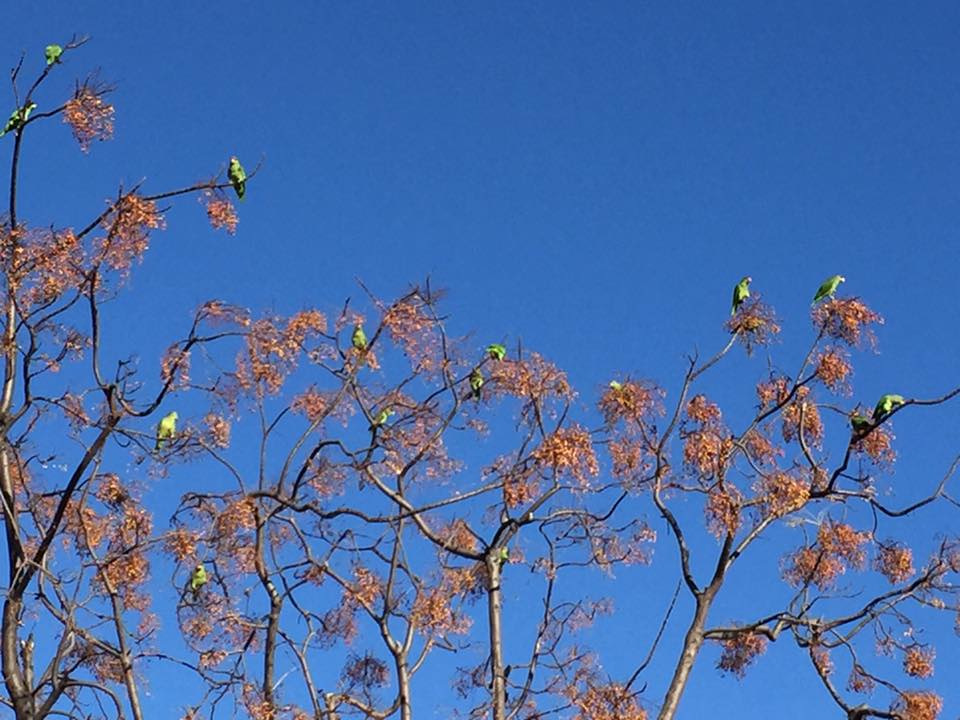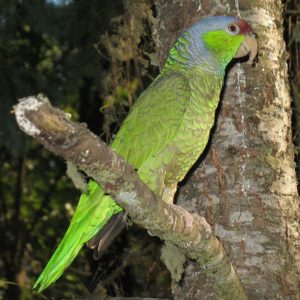
Despite the blustery wind and rainy weather, for some spring arrived a few weeks early this year. Wild parrots who normally arrive in March came in mid-February and have quickly become the talk of the town. People have reported seeing them fly over the golf course and down Glorietta. Others have spotted them near Walgreens and across town at Tenth and G.
For more than a decade the birds have been a harbinger. They arrive, typically in March, to breed and teach their young to fly.
By burrowing holes into the palm trees, “parrots build little condos then pop their heads out to look down at you,’’ said Jennie Portelli, a Coronado native who’s been following the parrots’ yearly patterns for years. Our giant palms are the perfect place to build. Many have holes already carved out and the birds simply move in.
Parrots also love our fruit trees. Loquat, fig, pine nuts, guava and coral tree nectar are their favorites. Last year city workers spotted parrots noshing on Canary Island date palms and carob tree pods.

After their babies are strong enough to fly, the parrots return home to El Cajon or La Mesa. The pattern rarely varies. They come in March and leave in June.
“We’ve been tracking them for a number of years and they follow the same route year after year,” said Josh Gridwell, co-founder of SoCal Parrot. The volunteer group protects, rescues, and rehabilitates wild parrots.
The parrots are decedents of birds that most likely migrated from Mexico in the late 1950s or early 1960s. There are now some 600 birds and 26 varieties living in San Diego county. Two species seen in Coronado are the Red-crowned Amazon and the Lilac-crowned Amazon, according to Sarah Mansfield, Operations Manager at SoCal Parrot.

No one knows for sure what brought them here. Mansfield suspects they escaped from smugglers who intended to bring here for sale on the black market. “Fearing discovery and a fine at the border, they simply let the birds fly away,” Mansfield said.
Flocks are now found in Point Loma, Imperial Beach and Ocean Beach.
Like all parrots, Amazons mate for life and can live up to 70 years. They breed once a year. They rarely have more than two and form close bonds with their offspring.
“Parents recognize their babies and even name them,” Mansfield said. While parents closely identify, the entire flock takes responsibility for their young. Click to read this NPR article on parrots naming their young which includes this Lab of Ornithology video on parrot parenting:
The birds are endangered. There are less than 3,000 red-crowned Amazons and less than 6,000 lilac-crowned Amazons left in the world, according to the SoCal Parrot website.
While the coast offers an ideal environment for breeding and nurturing, it is not a sanctuary. There have been incidents of poaching, most recently in Ocean Beach, Point Loma and Ramona. “In all incidents the culprits were teenagers with pellet guns,” Mansfield said.
Tree trimmers also pose hazards. Every year baby parrots and other birds are displaced by gardeners cutting back branches, according to the California Parrots newsletter.
The City of Coronado trims all of its trees, including the palms, between September and January. “This is the best time to trim for the health of the tree,” said Arturo Valdivia, Coronado Parks & Beaches Supervisor.
Even then the city is “super cautious and will not proceed if any type of bird is nesting,” Valdivia said. “Once we held up pruning a palm for five weeks due to finch and sparrow nests.”
Protecting parrots has become a community-wide endeavor. People love seeing the colorful birds fly around town and don’t want to see any harm come to them.
Reports of parrot poaching in other parts of the county have caused some residents to keep parrot sightings to themselves. “I don’t want to divulge where they reside for their protection,” Portelli said.




